Companies in various industries are now relying on artificial intelligence (AI) to work more efficiently and develop new, innovative products and business models. The games industry is no exception. After all, generative AI (genAI) is fundamentally changing both the way games are developed and the gaming experience itself.
As a data-driven company, InnoGames GmbH has been exploring the opportunities (but also the legal and ethical issues) that the technology brings with it for some time.
In this article you can read:
- How everyday AI work is organized at InnoGames
- Which genAI innovations developed in-house are being used
- How these are shaping the company’s path into a new gaming era
The foundation for genAI at InnoGames
AI is no longer a niche topic at InnoGames, but an integral part of how we work, providing creative impetus in many areas and contributing to innovative gaming experiences. AI plays a particularly important role in the early phase of game development, when new ideas are being developed, and initial concepts are taking shape. For example, AI-supported chat tools help our game designers to:
- Brainstorm ideas
- Test complex game mechanics
- Generate dialogs
They act as digital sparring partners that open up new perspectives and accelerate the creative process. AI does not always deliver the final result, but it is a good starting point for brainstorming.

InnoGames is a specialist for mobile and browser games such as “Rise of Cultures” (pictured), “Forge of Empires”, “Elvenar” or “The Tribes”.
InnoGames
AI-supported image generators, on the other hand, enrich the creation of concept art materials that visualize the atmosphere and style of a game. Our artists can test different styles and variations in the shortest possible time and thus achieve convincing results more quickly. With AI taking over time-consuming routine tasks, artists gain valuable time to experiment and develop unique visual worlds.
To ensure that employees have easy access to AI tools, InnoGames also uses the TypingMind platform, which provides a central point of contact for a variety of AI models, including ChatGPT and Gemini. For example, our employees can use this platform to:
- Chat with AI models
- Generate texts
- Create images
- Train their own AI agents with specific skills
To fully exploit the potential of AI, InnoGames also relies on an open and experimental approach. We encourage our teams to experiment with different AI models and platforms and explore new application fields. For example, as part of a recent internal “AI Jam,” which focused on developing innovative AI solutions through teamwork.
AI prototypes for better gaming experiences
However, the use of general tools alone is not enough to exploit the full potential of AI. The next logical step was therefore to develop customized AI solutions tailored to the specific needs and challenges of InnoGames.
Two approaches proved to be particularly promising: Retrieval Augmented Generation (RAG) and fine-tuning. On this basis, InnoGames has developed two internal prototypes: KAWAII and QueryMind. Both were created to address a fundamental problem in two respects:
- Data that remains unused: InnoGames collects more than 1.7 billion data records in real-time every day, based on player interactions with its games. In addition, there is various master data from different systems. Nevertheless, a lot of valuable information remains unused that could be relevant for strategic decisions, planning future projects and much more. However, accessing this information and gaining knowledge usually requires in-depth knowledge of SQL. QueryMind opens up new possibilities at this point.
- Knowledge that is not available: Like many other companies, InnoGames also uses wiki software to create documentation, record meeting minutes, discuss concepts and much more. Specifically, Confluence from Atlassian is used here. Anyone who has already built up an extensive knowledge database will be familiar with the difficulty of finding relevant information quickly and easily. This is where KAWAII comes in.
In the following, we take a detailed look at the two genAI prototypes developed in-house and how they work.
KAWAII
KAWAII stands for “Knowledge Assistant for Wiki with Artificial Intelligence and Interaction”. It is a prototype that implements the RAG approach to make InnoGames’ internal knowledge quickly and easily accessible.
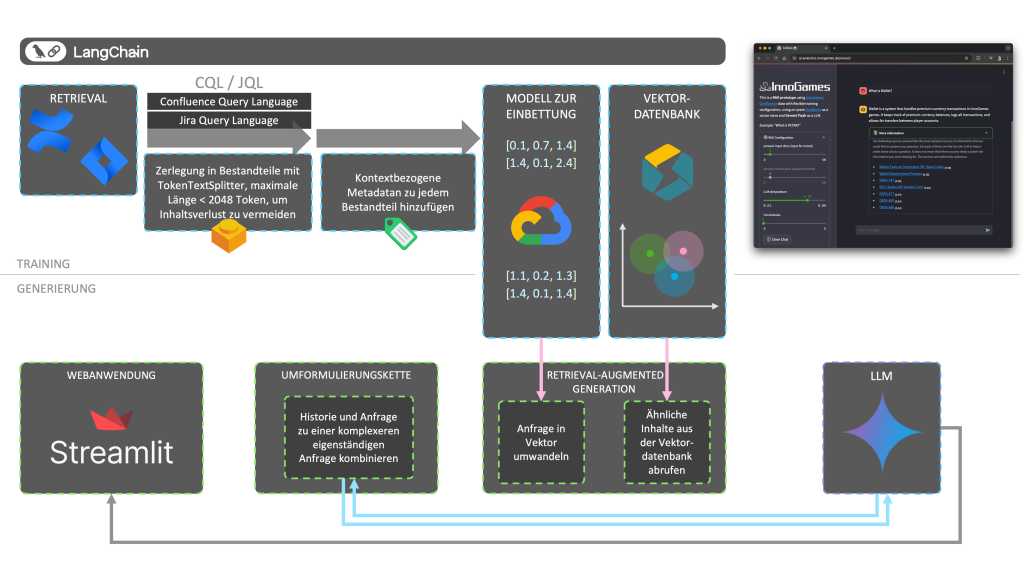
A detailed view of the KAWAII architecture.
InnoGames
KAWAII accesses data from our internal wiki and optionally also tickets from Jira. However, the focus is on the wiki content. To ensure the relevance of the information and avoid outdated data, we can use the Confluence Query Language (CQL) to specifically select the wiki pages that are to be integrated into KAWAII.
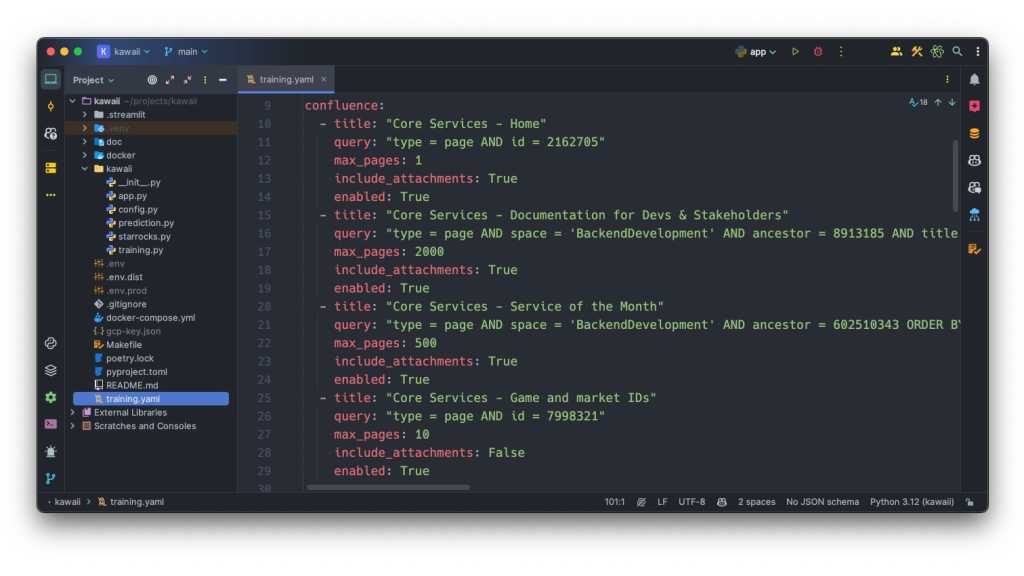
KAWAII training data as YAML configuration.
InnoGames
However, before the wiki pages can be processed for the AI, they must be broken down into smaller, semantically meaningful units — so-called chunks. This process is called chunking and is crucial for the quality of the search results. To split the wiki pages into chunks with a size of 1024 tokens and an overlap of 150 tokens, we use LangChain’s TokenTextSplitter. The overlap ensures that connections between the chunks are retained.
To make the chunks accessible for the AI search, they are converted into numerical vectors using embedding models. We use Google text embeddings, which support a maximum chunk size of 2048 tokens. In addition to the vectors, contextual headings are added to each chunk. These contain the page title and other metadata to ensure that each chunk retains its reference to the original wiki page even when viewed in isolation.
The text, the vectors and the metadata of the chunks are stored in a database that can process vectors and calculate distances. The open-source database StarRocks, which is already integrated into InnoGames’ data infrastructure and has an interface to LangChain, is used for this purpose. With functions such as cosine_similarity_norm, StarRocks enables efficient similarity searches between the vectors.
KAWAII uses a user-friendly web interface developed with Streamlit in Python to make queries in natural language. For example, an employee can ask what a certain InnoGames-specific KPI means. The entire conversation history is added to each new query to enable follow-up questions. To optimize the results, this history is reformulated together with the current input into a new, concise and unique question using the large language model (LLM) Gemini Flash.
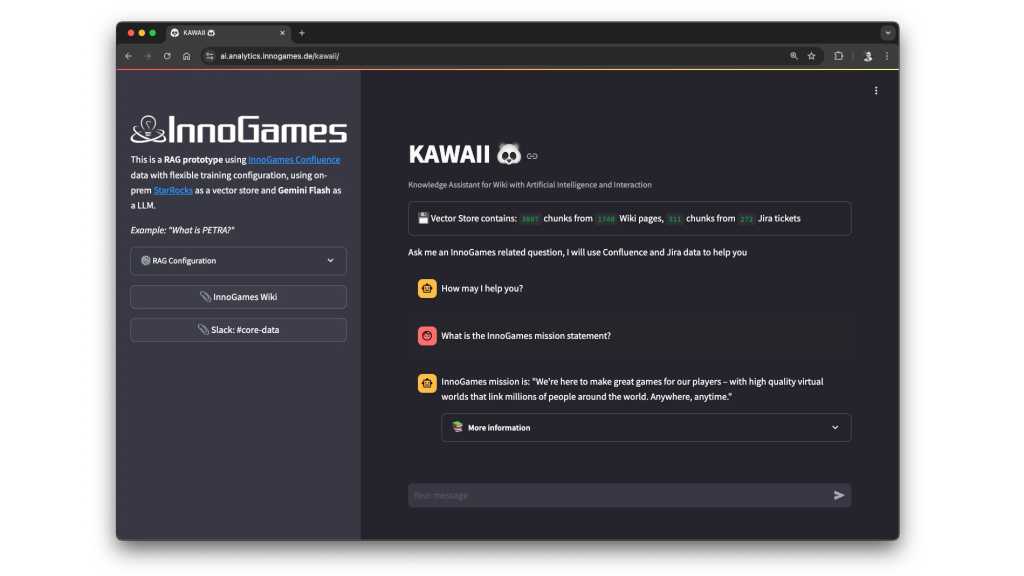
The KAWAII frontend.
InnoGames
This reformulated question is then converted into a numerical vector using the Google text embeddings as before. Based on this vector, the most relevant chunks are retrieved from the vector database. The reformulated question and the queried context are then passed back to Gemini Flash to generate a final answer. In this way, users receive precise and context-related answers to their company-specific questions.
QueryMind
InnoGames’ data infrastructure has evolved over the years from an on-premises solution using open-source technologies such as Kafka, Flink, Hadoop and Hive to a hybrid architecture that also includes cloud services such as BigQuery and Vertex AI.
Our second prototype, QueryMind, makes it possible to query this extensive data landscape using natural language. QueryMind is based on the RAG approach and uses the flexible, open-source Python framework Vanna. This allows us to flexibly combine different components such as vector databases, LLMs and SQL databases to convert natural language into database queries, execute them and optionally interpret the results.
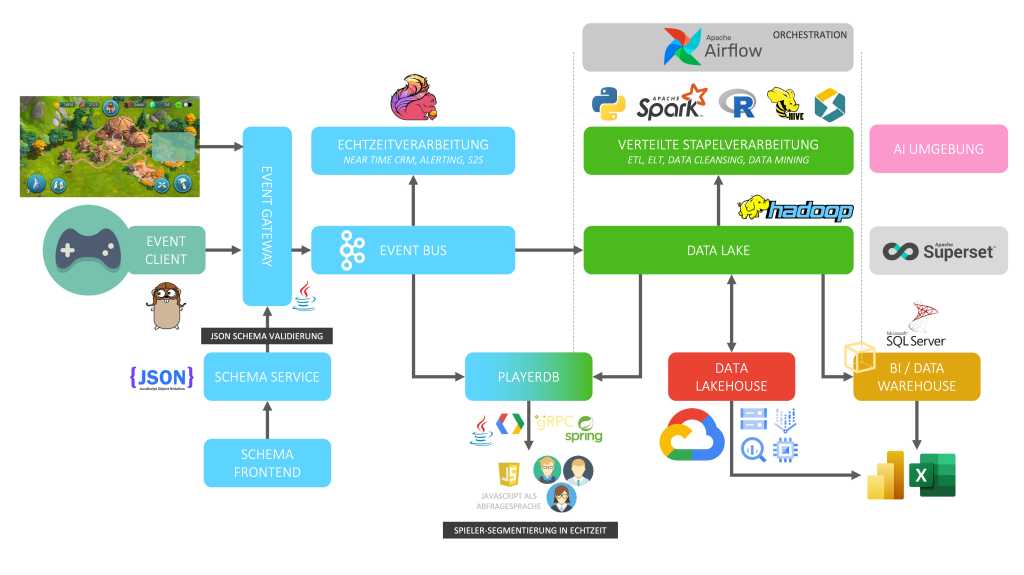
The data scene of InnoGames at a glance.
InnoGames
For QueryMind, we opted for the following components:
- StarRocks as vector and SQL database
- Gemini Flash as the underlying LLM
- Streamlit for the user interfaces.
QueryMind training is based on information about the table structure, sample queries and documentation.
Using the intuitive Streamlit interface, employees can now ask questions in natural language without the need for SQL knowledge. In concrete terms, such a question could look something like the screenshot below.
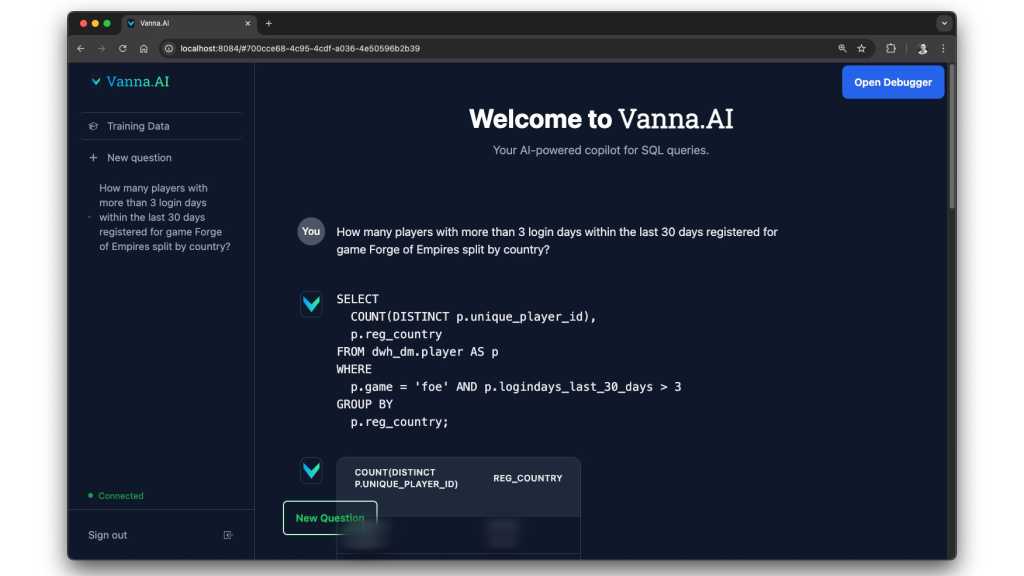
QueryMind in practical use.
InnoGames
QueryMind automatically translates this query into an SQL query, executes it on StarRocks and presents the results in an easy-to-understand format. This makes valuable knowledge for data-driven decisions accessible to a wider range of employees.
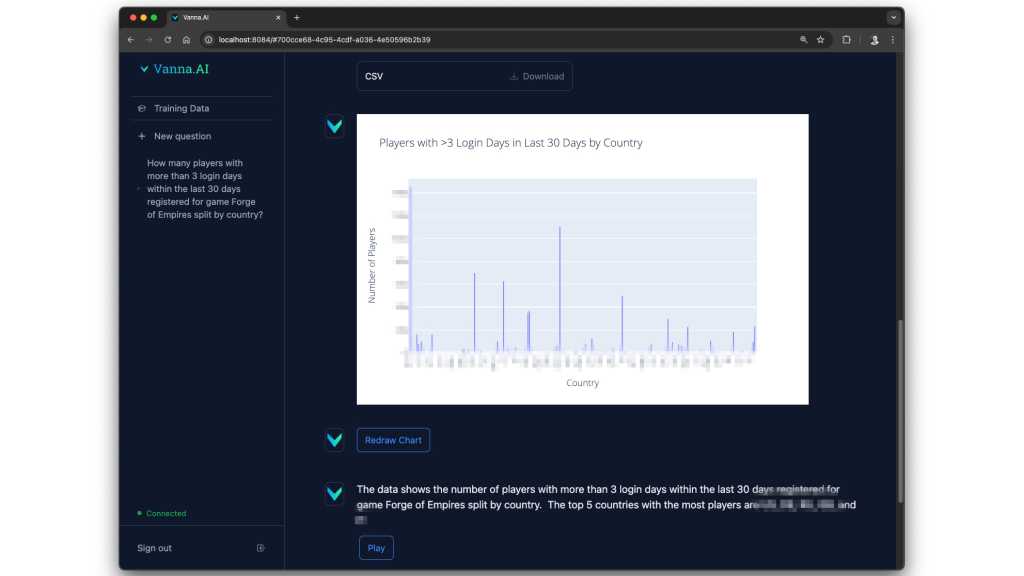
A glance at the results of the QueryMind query.
InnoGames
The AI-driven gaming future
The KAWAII and QueryMind prototypes presented are just the beginning. The future of AI in gaming holds enormous potential that goes far beyond optimizing internal processes. For example, a future version of KAWAII could be used to generate new game content such as quests and dialogs. In addition, AI technologies such as generative agents and neural game engines open up further new possibilities:
- Imagine, for example, a virtual world like “Smallville”, as described in the specialist article “Generative Agents: Interactive Simulacra of Human Behavior” (PDF). In this world, AI-controlled characters live their everyday lives, build relationships, exchange information and react to the actions of the players — all based on their individual (AI-generated) memories and personalities.
- Games that are no longer based on manually programmed logic but are generated in real-time by AI models such as “GameNGen” would also be possible. This could lead to more dynamic and unpredictable gaming experiences, as illustrated in the white paper “Diffusion Models Are Real-Time Game Engines” (PDF).
- AI-supported animation tools can also revolutionize games with realistic and expressive movements. They can “learn” these using video material or motion capture data and transfer them to game characters — as offered by animation specialist Motorica, for example.
- Another example of future AI innovations in the games sector is the “AI Dungeon” project. Here, an AI system takes on the role of a dynamic narrator that adapts the game plot to the player’s decisions and thus ensures an individual and immersive experience.
Whether generative AI is used as a supporting tool in game development or as part of the game in the form of AI-driven narratives, animations or NPCs, the technology will fundamentally change the gaming landscape in the coming years. InnoGames GmbH wants to play an active role in shaping this development.
Volker Janz has been part of the data team at InnoGames GmbH for over a decade. He develops and maintains distributed systems with a focus on data engineering, big data and AI.
Read More from This Article: Behind the scenes: The daily impact of genAI at Hamburg’s largest gaming company
Source: News

